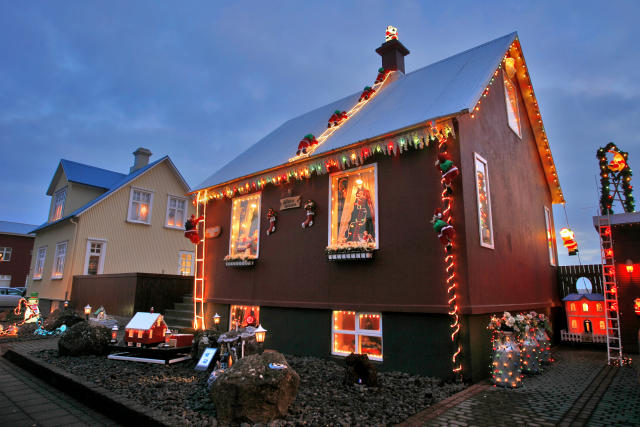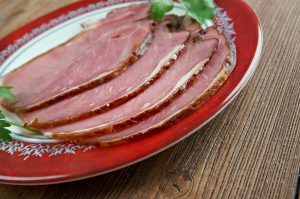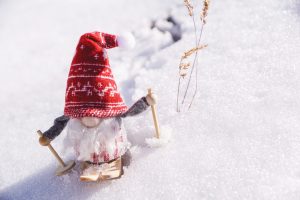Glittering ice, snowy mountains, the Northern Lights…winter is a magical time of year in Iceland, and it only gets better at Christmastime. But what is an authentic Icelandic Christmas like? How do we celebrate this most important wintery holiday?
Read on to find out about our unique Icelandic Christmas traditions!

Christmas Calendar in Iceland
In many parts of the world, Christmas comes and goes in a single day. Not so in Iceland! Our celebrations stretch from December 11th to January 6th, and we thoroughly enjoy the whole season.
In December, the weather is cold and crisp, the days are very short, and snowfall is common. But the long, dark nights are lit by countless twinkling Christmas lights and Advent lights, a spirit of warm conviviality, and of course… the famed Northern Lights! There’s no better time of year to experience this unique wonder.
History of Christmas in Iceland
Before Iceland was Christianized in 1000 AD, pagan Icelanders (like other Northern Europeans) celebrated the winter solstice. After Christianity spread, the winter solstice festivities were combined with the celebration of the birth of Christ.
The Christmas season in Iceland is known as Jól, which comes from the Old Norse language and is the equivalent of “Yule” in Old English.

Christmas Decorations and Preparations
The preparations for Jól are an event in and of themselves! Icelanders love to decorate for the holiday, and this begins with a thorough deep cleaning of the home. Then, each family decorates with a dazzling array of advent candelabras, wreaths, garlands, and other Christmas decorations.
The Christmas tree is dressed with lights, garlands, and ornaments, and is usually topped with a star or crown.
We do a lot of cooking and baking during this time, so we’ll have plenty of seasonal treats on hand for the many friends and family that are sure to visit during the holidays!

Icelandic Christmas Food
Some special Icelandic foods are prepared more frequently during Christmas and help us get into the spirit.
Laufabrauð is beautiful, delicious, and utterly Icelandic! This wafer-thin, deep-fried traditional bread is decorated with intricate snowflake-like patterns, and it’s a Christmas staple. Many families love to get together and spend time carving the decorations into the dough. We eat laufabrauð as a snack throughout the holiday season or paired with…
Hangikjöt, which is Icelandic smoked lamb. It’s usually boiled and sliced and served hot or cold. Almost everyone in Iceland eats this during Jól, and a traditional way of serving it is alongside potatoes, peas, and a creamy white sauce.
Kæst skata, or fermented skate, is traditionally eaten on the 23rd of December. More and more, Icelanders opt to eat this dish out in restaurants rather than in the home. Why, you ask? Well, it’s because of the stench! Considered a delicacy by many, no one can deny that kæst skata has a pungent odour that really tends to linger.
Wash it all down with our local Jólaöl, or Christmas Ale! A mix of malt extract and orange soda, this drink is everywhere during the holiday season, and though it may sound a bit strange, you should definitely give it a try. Other traditional Christmas foods in Iceland include ham, home-baked Christmas cookies, clementines, and rice pudding.
The Yule Lads: 13 Visiting Santas?
Get ready for one of the more unique Icelandic Christmas traditions…we have not one Santa, but thirteen! OK, so they’re not really “Santas,” but rather “Yule Lads,” and they are mischievous beings that live in the mountains, play tricks, and are descended from trolls. This is what we call them:
Stekkjastaur (Sheepfold Stick)
Giljagaur (Gully Oaf)
Stúfur (Shorty)
Þvörusleikir (Spoon-licker)
Pottasleikir (Pot-licker)
Askasleikir (Bowl-licker)
Hurðaskellir (Door-slammer)
Skyrgámur (Skyr-glutton)
Bjúgnakrækir (Sausage-pilfer)
Gluggagægir (Peeper)
Gáttaþefur (Sniffer)
Ketkrókur (Meat-hook)
Kertasníkir (Candle-begger)
As you can see, their names give a clue to their individual vices! Ok, ok… so no rosy-cheeked “Jolly Old Saint Nick” here, but what do the Lads actually do?
Beginning on December 12th, the Lads come down from the mountains and into the town, one by one, to visit each home. Children put their best shoe out on the windowsill, and if they’ve been good, they can expect to get a small gift from each Yule Lad. Naughty children, however, will find their shoe stuffed with a rotten potato!
Christmas Eve and the Jólakötturinn
Christmas Eve is all about family, with a big focus on the children and creating a warm, comfortable atmosphere. Public services, shops, and restaurants are closed, and the streets are nearly deserted. Family members come from near and far to be together on this very important day.
The evening begins with a large, elaborate meal, which is thoroughly enjoyed by all. Next, the family gathers in the living room to get comfortable and exchange gifts. This is the part many children look forward to the most! Books are a hugely popular gift option, exchanged between children and adults alike.
But watch what you wear around Christmas! Legend has it that there’s a huge, vicious cat, called the Jólakötturinn, which lurks about Iceland ready to devour anyone who isn’t wearing at least one new piece of clothing on Christmas. No one wants their family members eaten by the Christmas Cat, so everyone makes sure their loved ones have new clothing to wear before Christmas!

New Year’s Eve
New Year’s Eve in Iceland is an impressive spectacle, and it’s the party of the year. You may expect fireworks, and Icelanders will not disappoint! We love to shoot fireworks, and they’re a big part of the celebrations on New Year’s Eve. But there’s much more to the evening:
We usually have a large dinner with family and friends, and then head out to the communal bonfires. There are almost 100 large bonfires around the country, and it’s fun to come together and enjoy the warmth and festive ambiance.
Then, most everyone heads home to watch the annual satire show, called Áramótaskaupið, which parodies the events of the past year. When we’ve finished laughing at ourselves, we head back out into the streets and the fireworks begin in earnest.
You’ll see them big and small, of every shape and colour. Families gather to watch the display, but most also shoot fireworks themselves- it’s a national pastime! Watch out- there will be fireworks flying every which way, all throughout the night, so be alert!
This is how we ring in the new year, with the sky full of light. Once midnight has passed, most people head to house parties or bars to continue the party into the wee hours. There’s a general atmosphere of merriness and cheer, and plenty of drink to go around!
Last Day of Christmas
The 6th of January, or “Þrettándinn,” is the official last day of the Jól season. Though we’re sad to see Christmas go, we know how to end on a high note, and we celebrate with more communal bonfires, elf dances, and fireworks.
What to do in Iceland over Christmas?
Iceland offers a lot of winter activities over the coldest and darkest season and the most popular and most recommended are the following:
Ice cave tours are the most popular activity between November and February. We highly recommend the tour Skaftafell Blue Ice Cave & glacier hike: a combination tour of ice cave exploring and a glacier hike.
Want to take a shot at seeing the magical northern lights? Join a Northern Lights minibus tour!
If you’re interested in more action based tours then we can recommend a Golden Circle & snorkelling tour and Snowmobiling from Reykjavík or from Gullfoss if you have your own car.
The festive, bright decorations that adorn every home during Jól go a long way toward lifting people’s spirit during this darkest, coldest time of the year, and many Icelanders say Christmas is their very favourite time. If you’re lucky enough to visit Iceland during the holiday season, I think you’ll agree it’s like nothing else in the world!
Gleðileg jól- Merry Christmas from Iceland!

christmasicelandtravelwinter





